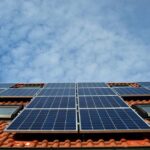In August 2022, President Joe Biden signed the Inflation Reduction Act (IRA) into law.
The IRA is a game changer for clean energy in the United States. While it also impacts Medicare and tax collections, it is the most sweeping climate legislation in U.S. history.
It includes just shy of $370 billion for various climate and clean energy programs. And a good chunk of those are directed at homeowners who want to make their homes more energy efficient.
This includes incentives for heat pumps, upgrading electric panels, fixing drafty homes and installing water heaters, furnaces and water boilers that run on propane, oil or natural gas.
It also includes incentives for solar panels and batteries. Which is what we’re going to focus on here because, after all, that’s what our site is all about!
Solar Incentives For Homeowners Under the Inflation Reduction Act of 2022
Before the IRA became law, there was a lot of uncertainty about solar incentives for homeowners.
There used to be a 30% tax credit for homeowners. That credit dropped to 26%, was due to drop to 22% in 2023, and would have gone away entirely in 2024.
The IRA changes all that.
It immediately reinstated the 30% tax credit for those who install solar or whole home batteries that have more than 3 kilowatt-hours of storage capacity (it also covers geothermal heating projects). And that 30% tax credit stays put for the next decade before it is phased out.
This takes off the pressure many homeowners may have felt to rush and get solar on their homes before the previous tax credit expired.
Also, good news for those who installed solar in 2022 before the IRA was signed into law… you will be eligible for the 30% tax credit.
Benefits For the Solar Industry
The IRA should help boost the solar industry – and related sectors by locking in solar tax credits for the next decade.
The stability should help increase job growth and economic development around this clean technology.
The IRA also contains provisions to help increase domestic mining of the materials we need to make solar panels and batteries. Not only should this create more jobs, but it has implications for national security by helping Americans produce energy and energy technology here at home.
Some of the funding to help accomplish this includes:
A $10 billion investment tax credit to help develop new manufacturing facilities that make solar panels (as well as electric vehicles and wind turbines).
Helping manufacturers in the U.S. accelerate the production of solar panels, batteries, etc., through production tax credits.
Bottom Line On the IRA
With the tax credits for homeowners and manufacturers, the IRA should help reduce the costs of solar and other clean technologies. This, in turn, should lead to a significant increase in the adoption of this technology and reduce our dependence on fossil fuels.
With energy prices rising, solar makes more sense for more homeowners. If you’d like to see how much you can save with solar, we recommend using the tool from UnderstandSolar.com here.






